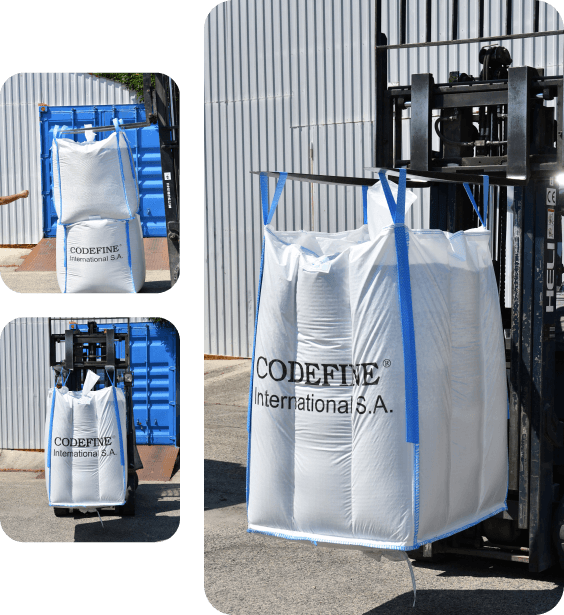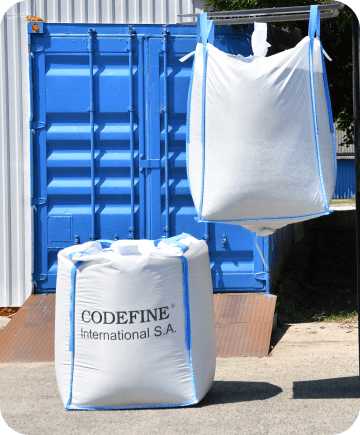Home » Posts Page » Blog » Products and Materials » Reducing Packaging Waste and Costs with the Right FIBC Size

Packaging waste in bulk material handling contexts extends far beyond the visible discarded materials. It encompasses excess packaging material, inefficient space utilization, product loss during transfers, contamination issues, and unused capacity throughout the supply chain. For FIBC operations specifically, waste manifests through oversized bags with unfilled capacity, undersized bags requiring multiple units, material degradation during storage, handling damage, and disposal of single-use containers that could have been reused.
The most common sources of waste in FIBC usage include standardized sizing that doesn’t match actual product requirements, improper bag type selection for specific materials, inadequate filling equipment that leaves excess capacity, limited reuse of suitable containers, and insufficient planning for seasonal volume variations. These inefficiencies often become systemic as operations standardize around suboptimal practices, creating persistent waste streams that organizations accept as normal operational costs.
Environmental impacts of improper FIBC sizing compound quickly across high-volume operations. Excess polypropylene fabric production consumes unnecessary petroleum resources and energy, while larger-than-needed bags increase transportation emissions through reduced load density. Wasted warehouse space from inefficient container stacking increases facility footprints and associated energy consumption. Premature container disposal adds to the landfill burden, with polypropylene materials taking decades to decompose. These ecological consequences grow proportionally with operational scale, making proper sizing increasingly critical for large-volume handlers.
Economic consequences of packaging waste directly affect your operational profitability through multiple channels. Excess material usage inflates purchasing costs, while inefficient container filling increases labor expenses per unit of product. Transportation inefficiencies from improper sizing drive up freight costs and fuel surcharges. Warehouse space consumed by oversized containers or extra units increases storage expenses.
The direct correlation between proper FIBC sizing and waste minimization permeates every aspect of bulk material handling. When your container size precisely matches product volume requirements, you eliminate multiple sources of waste simultaneously. Material consumption decreases as bags are sized appropriately for their contents, avoiding excess fabric production. Filling operations become more efficient with containers matched to production batch sizes. Transportation capacity is maximized fully, optimizing the product-to-packaging ratio per shipment. Storage space is optimized as containers stack efficiently without wasted vertical space.
Oversized FIBCs create numerous waste streams that affect operational efficiency. The most obvious waste comes from excess material production and consumption, with larger bags requiring more polypropylene fabric than necessary for the contained product. Transportation inefficiencies compound this waste, as oversized bags consume valuable cargo space while moving partially filled containers. Loading and unloading procedures take longer with larger-than-necessary bags, increasing labor costs per unit of product. Storage inefficiencies arise from oversized containers occupying excessive warehouse space, particularly when stacking stability becomes compromised by partially filled bags.
Undersized FIBCs create different but equally problematic waste patterns. The primary inefficiency comes from requiring multiple containers for material volumes that could fit in fewer properly sized bags, increasing total packaging material consumption. Handling waste proliferates as workers must process multiple containers instead of single units, multiplying labor requirements for equivalent product volumes. Documentation and tracking waste grow with increased container counts, as each unit requires separate identification, labeling, and inventory management.
Transportation efficiency gains from optimal FIBC dimensions create both environmental and financial benefits. Right-sized containers maximize vehicle load density, reducing the total number of shipments required for equivalent product volumes. This consolidation directly decreases fuel consumption, emissions, and freight costs across the supply chain. Container stability during transport improves with properly sized bags, reducing product damage and associated waste.
Comprehensive material volume analysis forms the foundation of effective FIBC sizing optimization. Begin by collecting detailed data on your material properties, including bulk density, flow characteristics, moisture content, and particle size distribution. Track actual production and shipping volumes across multiple time periods to identify patterns, variations, and outliers that influence container size requirements. Analyze filling and discharge methods to understand how material handling affects optimal container capacity.
FIBC capacity calculation requires consideration of multiple factors beyond simple volume metrics. Start with basic density calculations to determine the weight-to-volume relationship for your specific materials. Account for material compaction during filling and transport, which can significantly impact effective capacity utilization. Consider material flow characteristics that affect filling uniformity and discharge efficiency. Evaluate safety factors required for specific materials, particularly for hazardous or valuable products that require extra containment safeguards.
Custom sizing options offer significant waste reduction potential for operations with specific requirements that standard FIBCs cannot efficiently accommodate. Evaluate whether your volumes, material characteristics, or handling processes justify custom-sized solutions versus standard options. Consider modular sizing approaches that combine standardization benefits with customization flexibility. Assess the economic tradeoff between higher unit costs for custom sizes against waste reduction benefits across the operation.
Direct material cost savings represent the most immediately visible financial benefit of optimized FIBC sizing. Right-sized containers reduce polypropylene fabric consumption, lowering per-unit costs through the elimination of unnecessary material. For operations using thousands of containers annually, even modest size optimizations can yield substantial cumulative savings. Beyond the primary container, associated material costs also decrease through optimization.
Transportation cost reductions often represent the largest financial benefit from FIBC sizing optimization, particularly for operations with extensive distribution networks. Freight expenses decrease proportionally with improved container efficiency, as fewer shipments transport equivalent product volumes. Fuel surcharges reduce through better vehicle utilization and load density improvements. Handling costs at transportation transition points decrease with
Storage cost optimization delivers both immediate and long-term financial benefits through proper FIBC sizing. Warehouse space requirements decrease with optimized containers that maximize storage density, potentially avoiding facility expansion or allowing space reallocation to value-adding activities. Inventory carrying costs reduce with right-sized container inventories that minimize working capital tied up in packaging materials.
Standardization approaches for FIBC sizing across operations create systemic waste reduction while simplifying work processes. Begin by categorizing your product portfolio based on density, volume, handling requirements, and other relevant characteristics that influence optimal container sizing. Develop standardized size categories that efficiently accommodate these
Employee training programs convert waste reduction principles into daily operational practices. Develop comprehensive training that explains both the environmental and financial importance of proper FIBC sizing. Create role-specific modules that address the particular waste reduction responsibilities of different positions throughout your organization. Establish refresher training schedules that reinforce key concepts and introduce new waste reduction strategies as they develop.
Key performance indicators establish the measurement foundation for FIBC waste reduction initiatives. Track material utilization rates across different container sizes to identify optimization opportunities. Monitor transportation efficiency metrics including load density and shipment consolidation ratios. Measure labor productivity improvements through reduced handling time per unit of product moved. Document storage space utilization improvements that result from optimized container sizing.
Data collection methods should combine automated tracking systems with manual verification processes. Automated inventory management systems can track container usage patterns and highlight sizing inefficiencies. Manual audits verify data accuracy while capturing qualitative insights about operational challenges and opportunities. Regular assessment cycles ensure that measurement systems remain aligned with changing operational requirements.
Continuous monitoring and adjustment strategies prevent performance regression while identifying new optimization opportunities. Establish monthly review processes that evaluate key metrics against established targets. Create feedback mechanisms that capture frontline insights about sizing effectiveness and operational challenges. Develop response protocols for addressing performance variations or identifying system improvements that enhance waste reduction capabilities.
Codefine brings unparalleled expertise to sustainable FIBC solutions and waste reduction initiatives. Custom FIBC sizing services represent a core Codefine capability, with engineering teams that analyze your specific operational requirements to develop optimized container specifications. Their consultation process examines material characteristics, handling equipment limitations, storage constraints, and transportation requirements to identify the most efficient sizing solutions. This detailed analysis ensures that recommended container sizes deliver maximum waste reduction while maintaining operational effectiveness.
The Codefine FIBC product range encompasses all major container types (A, B, C, and D) and construction variants, including baffle bags, U-panel designs, and Q bags optimized for waste reduction and operational efficiency. Their manufacturing capabilities enable custom sizing solutions that precisely match your operational requirements rather than forcing compromises with standard sizes that create systematic inefficiencies.
Container liner solutions enhance sustainability performance by protecting product quality while enabling container reuse across multiple applications. These specialized liners transform standard FIBCs into packaging suitable for sensitive materials while supporting circular economy principles that minimize overall environmental impact.
Why not explore our complete product range online today? Do you have a question? Get in touch to speak to the team or to arrange a quote today.
